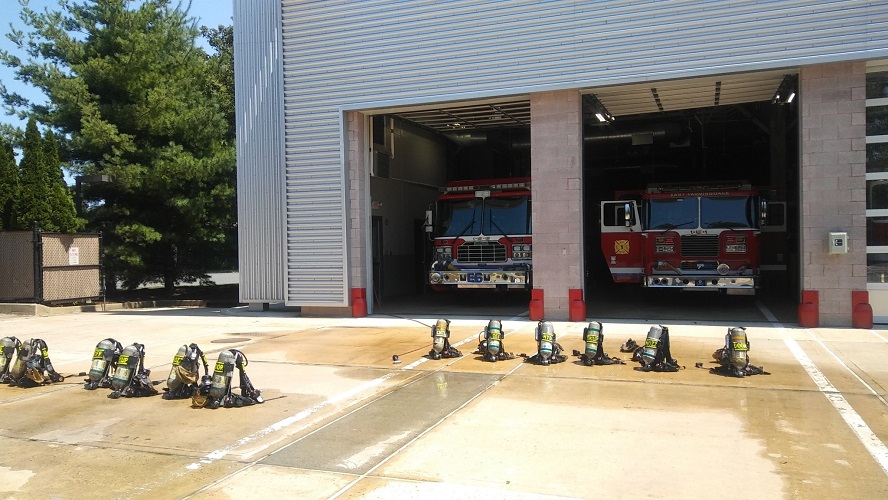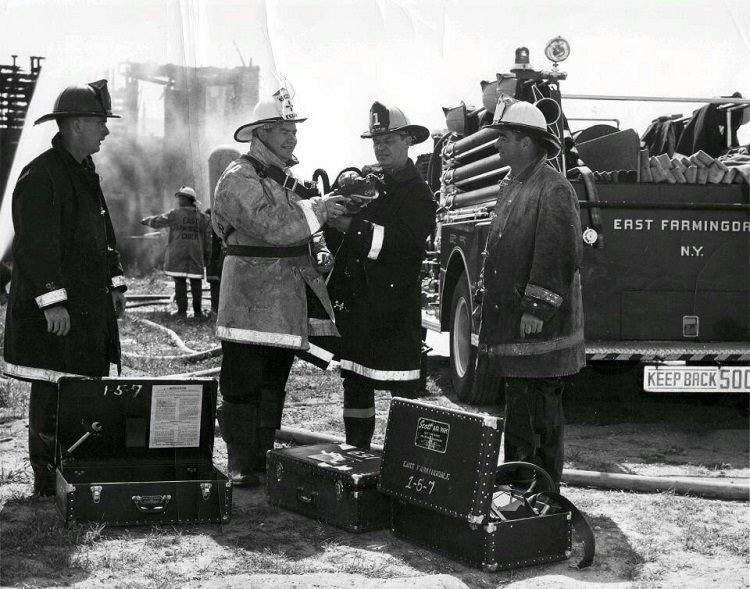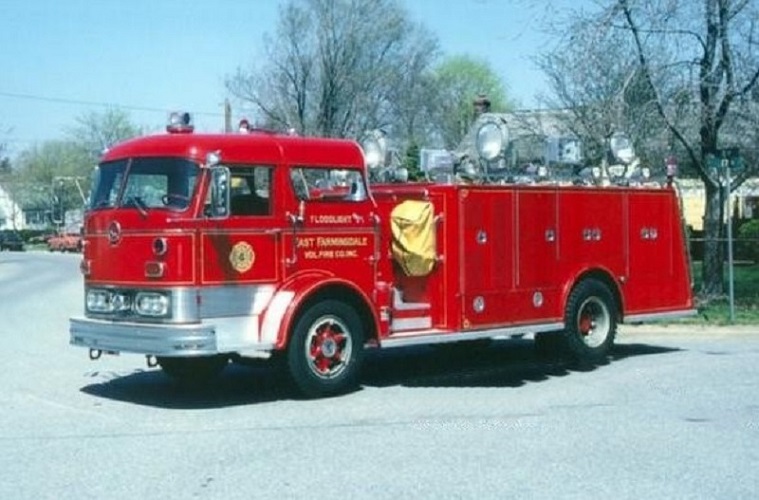By Frank Leeb
Lately, there has been great debate on the clean cab concept, specifically removing self-contained breathing apparatus (SCBAs) from the crew cab and placing them in a cabinet. At its core, this modification is based on a desire to minimize firefighters’ risk of cancer. The logic goes, if the dirty or contaminated SCBA are not in the crew cab, they will not pose a risk to the firefighters. The desire to minimize or manage firefighters’ exposure or risk is a well-placed and justified concern. However, is removing the SCBA from the crew cab the best option?
Managing risk is an important responsibility of our leaders, and part of this responsibility is managing risk caused from occupational exposure. Firefighting is an inherently dirty job. How can we best protect firefighters from contamination and cross-contamination from occupational exposure to the toxic residue of the fireground? This is the question the fire service has been trying to answer.
Maintaining a clean cab and protecting firefighter health are vitally important. However, how a clean cab is achieved while ensuring optimal operational outcomes is also important.
RELATED
- The ‘Clean Cab Concept’ Becomes a Reality
- Two Florida Departments Implement Clean Cab Concept
- The Cleaner Cab
- “Clean Cab” Is Not a Dirty Term
Defining a “New” Clean Cab Concept
A redefined clean cab concept should be defined as a strategy that minimizes to the greatest degree possible the fireground contaminants that enter the crew cab while considering firefighter health and optimal operational outcomes. This new concept includes emphasizing on-scene decontamination and keeping SCBAs in the crew cab. If equipment stored in the crew cab, including the SCBAs, are vigilantly cleaned on scene, they can and should remain in the crew cab.
Adequately washing the SCBA with soap and water on scene is a prudent step that should be taken as part of a clean cab strategy. This should apply not only to the SCBA but also to any equipment stored within the crew cab such as flashlights and firefighter personal protective equipment (PPE). Wiping down hard surfaces to remove contaminants that settle on them is also prudent. Ensuring that dirty equipment is never stored inside the crew cab and maintaining the clean cab must be everyone’s responsibility.
 (1) Following training, members cleaned the SCBA before placing them back on the fire trucks. This is important to maintaining a clean cab. (Photos by author.)
(1) Following training, members cleaned the SCBA before placing them back on the fire trucks. This is important to maintaining a clean cab. (Photos by author.)
The immediate objective is to remove as much fireground contamination while still on scene (preliminary exposure reduction) and not take the contaminants back to the firehouse and potentially cross-contaminating additional locations. When done correctly, this minimizes exposure and cross-contamination to the apparatus, the firehouse, and your car and your home. However, keep in mind that firefighters riding in the cab returning to the firehouse following a fire are contaminated because they have not yet showered or changed into clean station wear.
“A median reduction of 85% to maintain 100% firefighter readiness”
Soot is generally composed of lipid soluble compounds such as polycyclic aromatic hydrocarbons (PAHs) that are on the contaminated SCBA and other equipment. This contamination can be washed off on scene with soap, water, and hard scrubbing with an industrial scrub brush until you create bubbles. Recent research on firefighter PPE decontamination showed a median reduction of contaminants of 85% during on-scene wet decontamination. Although decontamination of equipment was not specifically part of this research, it appears that it would be prudent to use this procedure to decontaminate equipment before placing it back on the fire truck. Thoroughly washing equipment on scene takes little time.
Keeping SCBAs in the Crew Cab
When we look back on the history of the SCBA, there was a time when it was stored in a case in a compartment on the fire truck. We know that during some of these years, first-arriving firefighters rarely used the SCBA. They worked without this newly afforded protection.
 (2) When the SCBA was first introduced, firefighters often did not use it because they wanted to save time. [Photo courtesy of the East Farmingdale (NY) Fire Department.]
(2) When the SCBA was first introduced, firefighters often did not use it because they wanted to save time. [Photo courtesy of the East Farmingdale (NY) Fire Department.]
Removing the SCBA from the cab will result in the wasting of critical seconds, delaying search and rescue and fire suppression. In the modern fire environment with its increased toxic synthetics and the resulting accelerated fire growth, seconds gained or lost could be critical. Additionally, in the firefighters’ haste to get to work, the removal of the SCBA from the crew cab may lead to an incomplete size-up and the missing of critical clues, especially when all of the stored SCBAs are on one side of the apparatus. In the firefighters’ efforts to make up this lost time, they may not take the steps necessary to ensure the SCBA is donned correctly and safely. On arrival to a working residential fire at 2 a.m., a firefighter confronted by a mother yelling that her baby is inside is going to do everything possible to accelerate the time to action.
Installing superior ventilation and filtration systems within the cab, having washable crew seats, and using bags to cover and isolate the SCBA and that can be unzipped before use are additional prudent options for protecting firefighters. These alternatives provide a greater return on investment while preserving precious time that would be lost by relocating the SCBAs.
 (3) Covers that isolate the SCBA and can be unzipped when needed can provide additional protection inside the crew cab. This photo from the 1970s shows the evolution of SCBA storage systems from the carrying case of the 1960s to the apparatus-mounted covered SCBA. [Photo courtesy of the East Farmingdale (NY) Fire Department.]
(3) Covers that isolate the SCBA and can be unzipped when needed can provide additional protection inside the crew cab. This photo from the 1970s shows the evolution of SCBA storage systems from the carrying case of the 1960s to the apparatus-mounted covered SCBA. [Photo courtesy of the East Farmingdale (NY) Fire Department.]
Alternative Options to Protect Firefighters
The fire service has a long, celebrated, and strong culture. This culture is built on bravery and courage and is defined by life preservation with smart aggressive fire suppression. We need to extend this culture to taking care of ourselves after the fire is out. It includes on-scene wet decon and showering and changing into clean station wear as soon as possible. It also includes using gear bags to transport gear and never storing your gear in living areas of your firehouse or home. And, of course, it includes strict compliance with SCBA use.
Additionally, leaders looking to protect their members should advocate for two sets of bunker gear, washers/extractors, exhaust capture devices on the rigs or in the stations, mandatory annual medicals, cancer screening, smoking- and alcohol-cessation programs, and physical fitness requirements.
It is vitally important to have leaders willing to take all the prudent steps necessary to protect their firefighters. Some leaders may be inclined or tempted to remove the SCBA from the crew cab as a step to protect their members. These leaders should be commended for being proactive. However, this may be a well-intended but misguided decision. A prudent strategy for reducing occupational exposure to fireground contaminants can be adapted from our radiation exposure acronym ALARA. We want our exposure to be As Low As Reasonably Achievable. However, in this quest, we must not allow our vision to be clouded as we balance firefighter safety and our core mission.
***
Fire departments can take many steps to reduce occupational exposure to fireground contaminants. The data on firefighter cancers are sobering. Firefighters’ increased cancer risk dictates that fire departments be proactive in protecting their firefighters. We must also carefully and thoroughly consider the potential secondary effects or unintended consequences of policies, procedures, or equipment changes. Redesigns in apparatus that necessitate a change in operations can take a generation to overcome if missteps are taken. For many departments, the lifetime of a piece of apparatus is upwards of 20 years. Undesirable design changes can adversely affect fire operations long after the initial purchase of the apparatus.
Personal accountability to ensure dirty equipment is never stored inside the crew cab and the vigilant maintenance of the clean cab must be everyone’s responsibility. The implementation and enforcement of polices that ensure equipment is cleaned on scene as part of a redefined clean cab concept is perhaps the best pathway forward.
We must consider the fire service’s core mission of preserving life and property while also basing our contamination-reduction strategies on science-based research, common sense, human nature, and experience.
BIO
FRANK LEEB has served the Fire Department of New York (FDNY) since 1992, currently serving in the rank of deputy chief. He is the current chair of the FDNY’s contamination reduction work group. Frank holds a bachelor’s degree in Fire Service Administration from SUNY and a master’s degree in Security Studies from the Naval Postgraduate School, Center for Homeland Defense and Security (CHDS). Frank is also a 35-year member of the East Farmingdale Fire Department on Long Island, New York.

